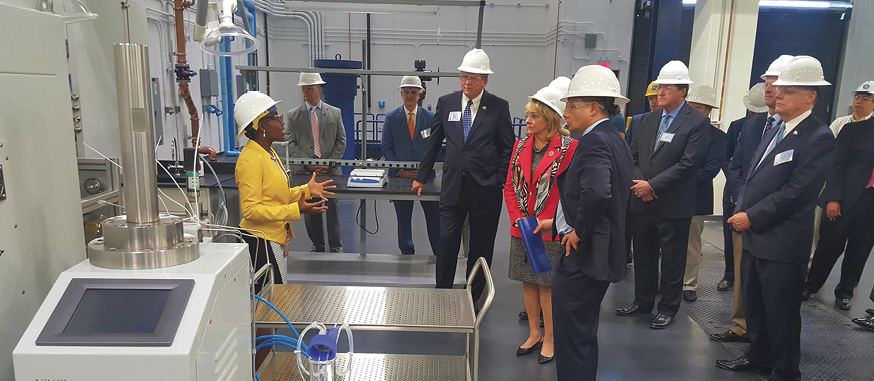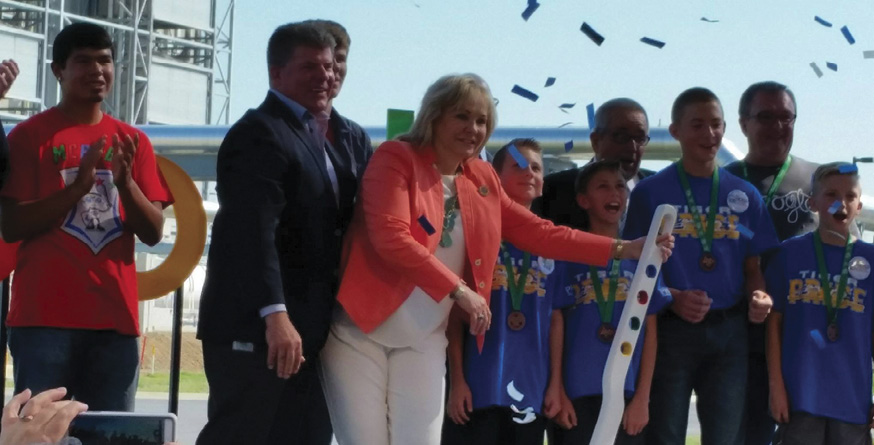- Home
- Media Kit
- Current Issue
- Past Issues
- Ad Specs-Submission
- Ad Print Settings
- Reprints (PDF)
- Photo Specifications (PDF)
- Contact Us

![]()
ONLINE

Oklahoma’s Advantage
Editors’ Note
In 2010, Mary Copeland Fallin was elected the first female governor of Oklahoma. She was reelected in 2014 to her second term by a 15-point margin, carrying 71 out of 77 Oklahoma counties. Since Fallin took office in 2011, Oklahoma has consistently ranked among the top states for job creation in the nation. Prior to serving as governor, Fallin represented the people of Oklahoma in a number of state and federal positions. She served two terms as a state representative before becoming Oklahoma’s first Republican and first female lieutenant governor in 1995. After serving as lieutenant governor for 12 years, Fallin served two terms in the U.S. House of Representatives from 2007 to 2011. Governor Fallin has signed bills to modernize and streamline government operations, responsibly cut the income tax, increase compensation for public employees, and address the state’s fiscally unstable pension system. The governor has also signed into law historic lawsuit reform and a complete overhaul of the state’s workers’ compensation system. At the governor’s direction, the state has increased funding for K-12 education by over $154 million, putting more money into the classroom and helping to boost student performance. As the former chairman of the National Governors Association, Governor Fallin led a nationwide initiative called “America Works: Education and Training for Tomorrow’s Jobs” seeking to better align education with 21st-century workforce needs. The governor is a graduate of Oklahoma State University.
What interested you in public service and made you want to run for Governor of Oklahoma?
Growing up, I didn’t imagine that I would be governor. However, I did always aspire to do something big with my life. My parents always told me to dream big and don’t let other people tell you that you can’t do something just because of your gender. I took that message and ran with it. My parents were my greatest influences and inspirations in my life. They always believed in me and always supported me. They were both state employees and both served as mayor of Tecumseh, Oklahoma. I watched how they handled situations and how much they cared about their community and state. That resonated within me, and I took that with me when I started my career in the private sector, then later into politics. I’ve really enjoyed serving the people of Oklahoma and working to increase the number of opportunities available to Oklahomans.

Governor Fallin at the opening of a GE facility in Oklahoma City
How do you define Oklahoma’s strengths and its competitive advantage from a business standpoint?
Low taxes, economic stability, reasonable regulations, and solid infrastructure – all of these make for a government policy that accelerates innovation. A highly-skilled, educated workforce is critical to attracting and retaining jobs, and one can find this in Oklahoma.
Oklahoma offers an incredibly low cost of doing business. We have the sixth-lowest tax burden, according to WalletHub.
Oklahoma has a low cost of living and low utility rates. Industrial electrical power costs are 28 percent lower than the national average. Oklahoma also has the Quality Jobs incentive, which promotes job growth and helps improve the bottom line for Oklahoma companies. Through this program, qualifying companies that create well-paying jobs are provided with a cash rebate.
Oklahoma offers world-class incentives. We are the only state in the nation that offers an engineering tax credit for engineers coming to work in the aerospace industry. The tax credit is available to both the employee and the company hiring them.
For those looking for a great place to invest in energy, I’m very proud that the 2016 Fraser Institute Global Petroleum Survey ranked Oklahoma number one for the best place to attract energy investments worldwide.
Oklahoma is home to more than 140 Foreign Direct Investment (FDI) companies, such as Lufthansa, Michelin, Siemens, and Umicore. FDI projects in Oklahoma are up 28 percent over the previous year.
Businesses looking to relocate to the United States benefit from Oklahoma’s central location, pro-business environment, available sites, and prepared workforce.
In Oklahoma, we believe that for government to accelerate innovation, it must work with industry to develop a diverse, well qualified workforce. Simply put – energy pipelines need talent pipelines. Workforce development is a top priority of my administration. It makes no sense to have a workforce development plan if it does not meet the needs of the job creators within private industry.

Governor Fallin at the opening of a
Google data center in Pryer, Oklahoma
Ensuring Oklahoma has a strong education system has been a top priority for your administration. How have you addressed education reform in Oklahoma, and are you happy with the impact you have made?
One of my top priorities has been increasing degrees and career certificates. In 2012, I launched a program called Complete College America. As a result, Oklahoma has increased our university and college degrees along with career certificates by 27 percent.
We have worked hard to increase education in STEM-related fields. Between 2009 and 2014, Oklahoma has seen a 29 percent increase in students graduating with STEM-related degrees and certificates.
My administration has seen improvements in student reading scores, thanks to the Reading Sufficiency Act, which ensures that students are on the proper reading level by the end of third grade. There have been significant results through this legislation, and in the past two years reading scores have increased by 9 percent.
I was able to implement the A-F Grading System for schools during my first year in office. This program allows parents, students, teachers, and administrators to know how their school is performing. It also allows for schools to see where they should focus on improvements and adjustments. Because of this system, there have been many schools that have been able to improve their school grade.
By launching Oklahoma Works in 2015, we created an initiative to increase the talent pipeline between K-12 education, career technology centers, higher education institutions, and businesses. The intent of Oklahoma Works is to boost education attainment and better align the workforce to the needs of employers. As a result of Oklahoma Works, I have created a program called “Launch Oklahoma” with the goal of having 70 percent of Oklahoma residents, aged 25-64, complete a postsecondary degree certificate or credential by 2025. That number currently stands at 40 percent.
Your administration has also placed a major emphasis on infrastructure investment and improving Oklahoma’s transportation system. How critical is this investment to the future growth and strength of Oklahoma?
Access to transportation via Oklahoma’s roads, railways, and river ways is an incredible asset to our businesses. We must ensure that these are efficient modes of transportation in order to continue to keep business costs down for Oklahoma companies.
While Oklahoma is not one of the nation’s most populous states, we rank 17th for the number of centerline highway miles – not far behind states like California and New York. This leaves a huge burden of maintenance for our state.
Oklahoma is home to 150 miles of inland waterways and one of the largest, inland ice-free river ports in the U.S., the Tulsa Port of Catoosa. Oklahoma’s waterways can ship to and from 20 states as well as global markets with access to the Gulf of Mexico.
In 2011, I launched an initiative to reduce the number of structurally deficient bridges in Oklahoma from more than 700 to zero by 2019. At the end of 2016, we had reduced that number to 270. We are continuing to make progress.
By launching the Driving Forward: Investing in Oklahoma’s Future program in 2015, I have been able to lay the groundwork for future turnpike transportation in Oklahoma. The Driving Forward plan consists of six large-scale projects that modernize, enhance and improve safety, reduce congestion, and support population growth on the turnpike system.
Personal and community safety is a top priority for your Administration. Would you discuss your efforts in this regard and Oklahoma’s “smart on crime” policies?
A state can be smart on crime while tough on true criminals. In August, I formed the Oklahoma Justice Reform Task Force and asked it to perform a comprehensive review of Oklahoma’s criminal justice system. It was tasked with developing data-driven recommendations that will increase public safety by reducing recidivism, holding offenders accountable and controlling the state’s skyrocketing corrections costs. We partnered with the Crime and Justice Institute and Pew Charitable Trusts to provide technical assistance to the task force. Since then, the members of the task force have spent countless hours studying data to craft fact-based recommendations. I greatly appreciate their hard work and tireless efforts in producing these findings. I look forward to working with the Legislature to continue the momentum on criminal justice reform.
You have been clear that Oklahoma must improve in regard to health. How is your Administration leading the effort for Oklahoma to “stand up and fight for better health”?
Oklahoma has a very successful program named Certified Healthy Oklahoma, which encourages businesses, schools, and communities to participate in healthy living options. In 2015, we had over 1,700 organizations involved with this program. It has continued to grow.
In December, we launched the Health 360 Program, which is an initiative across government agencies to improve health in Oklahoma. The priority health goals for this initiative are obesity, tobacco use, child health, and behavioral health. We have reduced our smoking rate dramatically, but more improvement must be made.
Smoking is the number one preventable cause of death in Oklahoma and costs our state $1.62 billion in healthcare costs. In my recent State of the State address, I once again asked the Legislature to increase the cigarette tax in Oklahoma. This will help decrease the number of people smoking, while at the same time provide additional revenue to spend on current healthcare needs.
In 2015, I signed into law legislation that took aim at our prescription drug abuse problem. The measure seeks to reduce “doctor shopping,” the practice of going to multiple physicians with requests for prescription narcotics, and to reduce the reliance on and inappropriate use of dangerous narcotics to treat pain. The law requires doctors to check a Prescription Monitoring Program (PMP) database before writing prescriptions for potentially dangerous and addictive drugs like oxycodone. By checking the database, doctors can reduce the likelihood that patients are seeking the same prescription drugs from more than one physician at a time.
I have been a consistent advocate for stronger PMP legislation as well as additional resources for substance abuse treatment and prevention during my time as governor.
Improving the health of Oklahomans is a top priority. An unhealthy population affects a state’s workforce and its health insurance premium cost and drives up a state’s Medicaid budget.
With gridlock and partisanship in government today, the public clearly has strong concerns for, and a lack of confidence in, its public officials. How have you been able to drive action and create change for Oklahoma in today’s political environment?
I have always been accessible and listen to people. The rapport I developed with the people I continue to serve today was essential to gaining their trust. I am looking for good ideas to solve today’s problems, and it doesn’t matter what political party one belongs to.
You are known as someone who is results oriented and likes to gets things done. Is it hard to be patient when you see the slow pace of change in government?
I’ve been in government long enough to understand the process. That doesn’t mean I don’t get frustrated with the process, but it’s there for a reason. We have to do our best to act within the boundaries set so we can enact positive change in our state.•